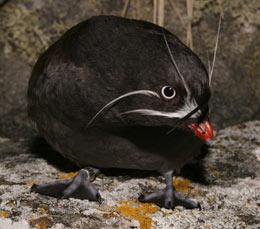Aptly named whiskered auklets (Aethia pygmaea ) breed on the volcanic Aleutian and Kuril Islands that rim the north Pacific. They lay their eggs in small chambers reached by narrow passageways through jagged lava rocks, which they enter and leave only at night.

|
| ©Ian Jones |
| Seeing in the dark: 'whiskers' help these birds to sense their surroundings. |
Whiskered auklets are the most elaborately decorated of the six known species of auklet, and are one of only two that are nocturnal. Striking stiff white feathers protrude from above and below the eyes of the otherwise slate-grey bird, and a dark plume swoops forward from the top of its head.
Sampath Seneviratne and Ian Jones of Memorial University in St John's, Newfoundland, Canada, wondered whether that array of feathers might provide a sense of touch to guide the birds in the dark.
Blind man's bluff
To test the idea, Seneviratne caught 99 birds at night as they left or returned to their nests on Buldir Island, one of the Aleutian Islands in Alaska, and set them in a wooden maze built to resemble the layout of a typical auklet nest. Then he watched the birds with an infrared video camera as they ducked to avoid overhead obstacles and counted the number of times the birds bumped their heads.
Each auklet shuffled through the darkened maze three times - once with their protruding facial feathers taped back, once with tape on their head but their long feathers free, and once completely unfettered.
Auklets sent through the course with their feathers taped back bumped their heads more than twice as often as they did when their feathers were free.
"That is novel, and interesting," says Robert Montgomerie of Queens University in Kingston, Ontario, Canada, who studies the evolution of ornamental plumage in birds but was not involved in this study. "I think this is the first study that shows that there's a real tactile advantage to having these feathers."
The spiky white feathers are a type called rictal bristles, which have been suspected to have a sensory function before. But this theory has been rarely tested, both Montgomerie and Seneviratne say, and with variable results. Bristle feathers that surround the beaks of flycatchers were thought to help detect insects, for example, but a similar experiment found that these birds had no trouble catching prey when their feathers were taped back.



Reader Comments
to our Newsletter